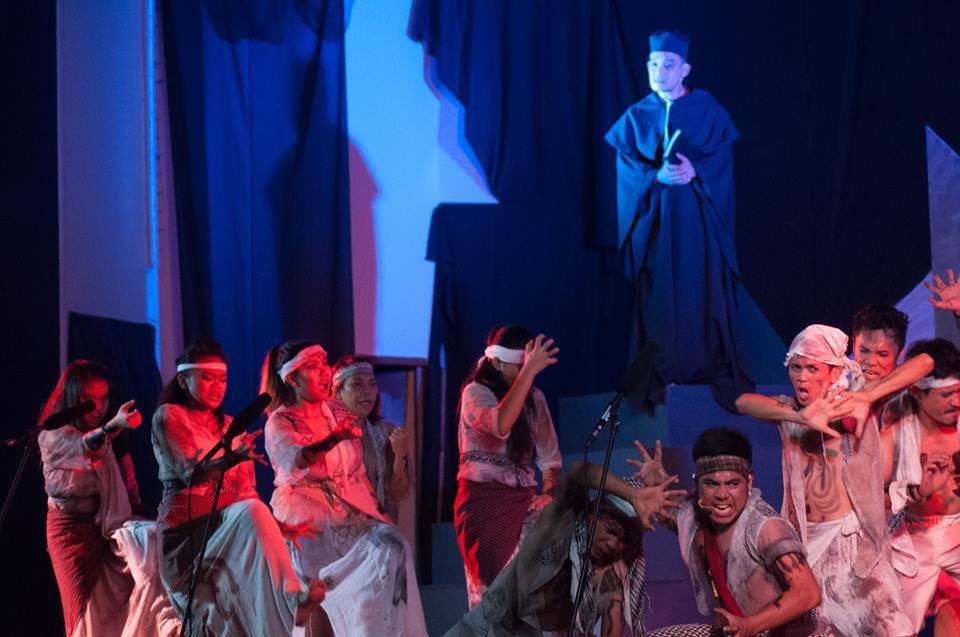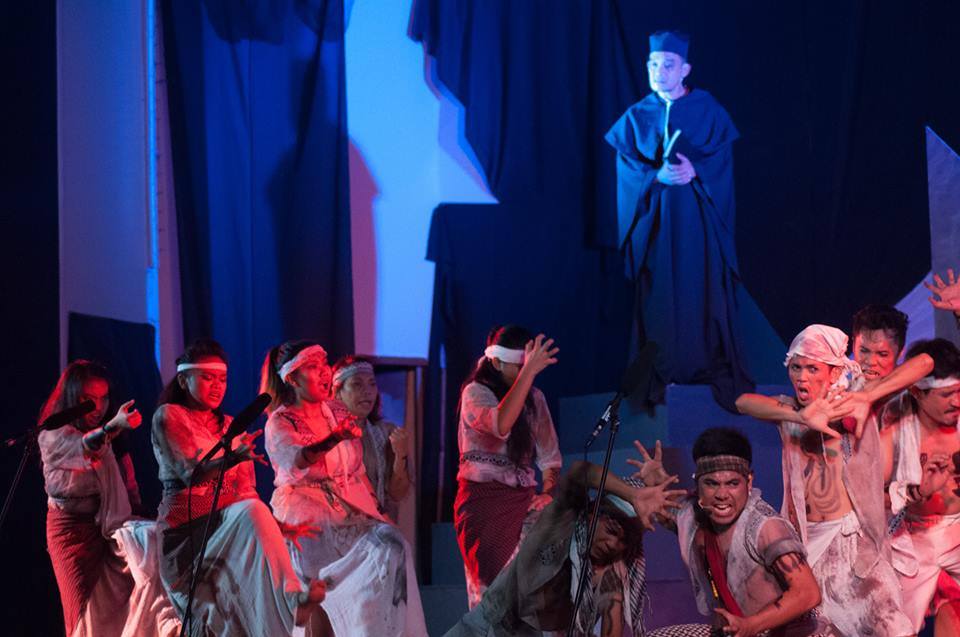TAGBILARAN, Bohol– “Dagon sa Hoyohoy” (Amulet of the Breeze) – Bohol’s first sung-through musical on the legendary hero Francisco Sandijas was a fitting cap for Bohol’s vibrant cultural scene for the year just passed.
Mounted by the Dulaang Kasing Sining Teatro Bol-anon Ensemble, the more compact production at the Bohol Cultural Center used minimal but flexible set, symbolic costumes, and a choreographic design that draws from both contemporary and traditional Philippine martial arts movements.
Community theater-inspired scenes in the audience of students taking selfies, classroom discussions on the play and the person of Dagohoy, and even the appearance of some of the major characters—opened the musical that aim to provide the Boholano community lessons and insights from its history “in a manner that is creative, imaginative, and culturally sensitive,” Lutgardo Labad, artistic director of the historical drama, said.
“Pruning the original libretto with playwright Marianito Luspo from 2.5 hours to some 1.5 hours, and editing musical sessions with composer Elvis Somosot demanded a new production concept and treatment,” Labad pointed out, adding that “the result is uniquely rewarding in a different sort of way. It is like giving birth to a totally new baby, full of new potentials and promise.”
First mounted in 1998 in time for the Philippine independence centennial celebration, the new Dagohoy musical employs a “more intimate, more nuanced” acting approach that “fused in the genre of music and movement theater” with largely new actors who grew up on backgrounds and contexts much different from the cast in the late 90s, Labad said.
“Now in the time of the millennials, almost a generation after that artistic milestone in 1998, there is a greater need to raise the consciousness of our youth and communities on the values and legacy of Dagohoy,” he added.
In the first act, the cast depicted “reduccion,” or forced labor, practiced during the Hispanic colonial era in building public infrastructures like churches, excessive tax collection and payment of tributes, in stylized dance movements. It established a seemingly small incident that triggered the longest revolt in Philippine history which lasted some 84 years in the small island of Bohol.
The second act showed what must have been a “mananambal” or medicine man Dahok Tambalan played wittily by Gerardo Calle Jr. in the pre-Hispanic mode who mixed knowledge of traditional medicine and belief in amulets, which even Katipuneros reportedly wore around their neck to gather courage and for “invincibility.”
In the third act when Dagohoy’s followers faced difficulties in resistance, a song called on the Boholano hero, “Balik kanamo Dagohoy, uban ang dagon sa huyohoy” (come back Dagohoy with the amulet of the breeze). It concluded with an exhortation: “Padayon tang pangitaon ang dalan sa kagawasan!” (Let’s continue looking for the road to freedom).
Jerrey D. Aguilar was compelling in his portrayal of Dagohoy first as a loyal subject of the church, then as one enamored by the possible magical power of the amulet, then as one hurt by the refusal of the priest to give a Christian burial to his brother, and finally as a leader of a rebellion against oppression.
Paul Vistal imbued the character of Fray Morales with just enough doctrinal and triumphalist air that could have drummed visions of hell to Boholanos who refused to bow to colonial requirements.
Marvin Abalao gave a short but meaningful portrayal of Sagarino. Mitch Aguilar, April Jay Banquil, Juliet Borja, Anjo Zairos Cozo, Geraldine Ramin, Kino Rara, Khris Marc Ronquillo, Lilet Sarabia and Schwyn Sarabia as people of Inabanga provided an ensemble that followed a flowing “éskrima” or arnis movement.
Bohol Governor Edgar M. Chatto commented, “This is one show which all Boholanos must see. All the towns of Bohol must witness this grand retelling of the courage of our beloved hero Dagohoy!”
He has endorsed the play as worthy of being shown all over Bohol. “We are wholeheartedly endorsing it for towns and school communities, to experience the dramatic re-telling of the life and struggles of our Boholano hero, brought to life in an exceedingly creative and compelling manner, ingenious and reflective of Boholano passion, commitment, and creativity.”
Noted film director Maryo de los Reyes, whose roots are from Bohol, remarked after watching the show, “A magnificent spectacle, spell binding drama on our most important hero, the great Dagohoy!”
Noel Mallonga, actor, producer, cultural management specialist, considered the musical “a riveting spectacle not to be missed…a testament to Bohol’s noble history. One leaves the theater proud to be Boholano, prouder to be Filipino!”
Bohol representative Rene Relampagos said that “the commemoration of Dagohoy’s acts of courage shall serve as a fitting reminder that we shall never forget the sacrifices of our heroes who gave up their lives to free the Philippines from oppression…”
He expressed hope that “Dagohoy and other heroes shall serve as role models to the Filipino youth in our fight against poverty, corruption, and crime and modern-day slavery.”
As recorded in Blair and Robertson, one day in 1744, Jesuit priest Father Gaspar Morales, curate of Inabangan (Inabanga town today), ordered a constable named Sagarino to capture a man who had abandoned his Christian faith, apparently considered a “crime” in those years.
The account goes that the constable pursued the fugitive, who resisted and killed Sagarino. His body was brought to the Inabanga church but Father Morales did not want to give his blessing and refused to give him a Christian burial because his death was purportedly a result of a duel, then considered a major infraction by the church.
Sendrijas, brother of Sagarino, and barangay chief, “was aghast and called on his fellow Inabangans to rise up against the priest and other oppressive Spaniards,” the same source said, adding that “more than 3000 natives followed Dagohoy to the hills of Danao where he established a locally governed community. The number rose to more than 20,000 when the rebellion spread throughout the entire Bohol.”
It was then that Francisco Sendrijas began to be called Dagohoy, a contraction of “dagon sa dagohoy,” and folklore started spreading that Dagohoy supposedly possessed the ability to appear and disappear at will—“sama sa hoyohoy” (like a soft breeze)—when Spanish authorities chased him in the mountains of Danao.
“Twenty Spanish governors-generals, from Gaspar de la Torre (1739-45) to Juan Antonio Martinez (1822-25), tried to quell the rebellion but they failed. In 1825, when General Mariano Ricafort became the governor-general of the Philippines, he ordered alcalde-mayor Jose Lazaro Cairo to Bohol at the head of 2,200 Filipino-Spanish troops…and invaded the island on May 7, 1827,” according to the “Concepcion Historia de Philippinas,” a report translated by Blair and Robertson.
Dagohoy himself died an old man, outliving his enemies, and his legacy was continued by his descendants in a new wave of rebellion. In 1828, another Spanish expedition under Captain Manuel Sanz came to Bohol. After more than a year of fierce campaign involving burning the mouth of a cave in Danao that forced some 200 followers of Dagohoy to come out due to smoke.
After the beheading of 200 followers, the rebellion ended on August 31, 1829. Some 19,420 survivors were pardoned and made to live in new villages in the lowland, a precursor of hamletting. These villages now comprise the towns of Batuan, Cabulao, Catigbian and Bilar.

